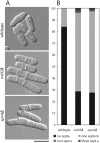Mid2p stabilizes septin rings during cytokinesis in fission yeast
- PMID: 12654901
- PMCID: PMC2172768
- DOI: 10.1083/jcb.200212016
Mid2p stabilizes septin rings during cytokinesis in fission yeast
Abstract
Septins are filament-forming proteins with a conserved role in cytokinesis. In the fission yeast Schizosaccharomyces pombe, septin rings appear to be involved primarily in cell-cell separation, a late stage in cytokinesis. Here, we identified a protein Mid2p on the basis of its sequence similarity to S. pombe Mid1p, Saccharomyces cerevisiae Bud4p, and Candida albicans Int1p. Like septin mutants, mid2delta mutants had delays in cell-cell separation. mid2delta mutants were defective in septin organization but not contractile ring closure or septum formation. In wild-type cells, septins assembled first during mitosis in a single ring and during septation developed into double rings that did not contract. In mid2delta cells, septins initially assembled in a single ring but during septation appeared in the cleavage furrow, forming a washer or disc structure. FRAP studies showed that septins are stable in wild-type cells but exchange 30-fold more rapidly in mid2delta cells. Mid2p colocalized with septins and required septins for its localization. A COOH-terminal pleckstrin homology domain of Mid2p was required for its localization and function. No genetic interactions were found between mid2 and the related gene mid1. Thus, these studies identify a new factor responsible for the proper stability and function of septins during cytokinesis.
Figures








References
-
- Altschul, S.F., W. Gish, W. Miller, E.W. Myers, and D.J. Lipman. 1990. Basic local alignment search tool. J. Mol. Biol. 215:403–410. - PubMed
-
- Bahler, J., J.Q. Wu, M.S. Longtine, N.G. Shah, A. McKenzie, A.B. Steever, A. Wach, P. Philippsen, and J.R. Pringle. 1998. b. Heterologous modules for efficient and versatile PCR-based gene targeting in Schizosaccharomyces pombe. Yeast. 14:943–951. - PubMed
-
- Balasubramanian, M.K., D. McCollum, and K.L. Gould. 1997. Cytokinesis in fission yeast Schizosaccharomyces pombe. Methods Enzymol. 283:494–506. - PubMed
Publication types
MeSH terms
Substances
LinkOut - more resources
Full Text Sources
Molecular Biology Databases
Miscellaneous

